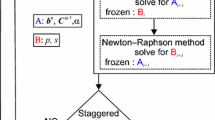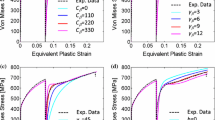Abstract
The paper presents the theoretical part of a method for the identification of the modified Cockroft–Latham ductile fracture criterion at elevated temperature. Quite a general viscoplastic model is adopted to describe material behavior. The original criterion is path-dependent and involves stresses. Therefore, the identification of constitutive parameters of this criterion, as well as many other ductile fracture criteria, is rather a difficult task that usually includes experimental research and numerical simulation. The latter is impossible without a precisely specified material model and boundary conditions. It is shown in the present paper that for a wide class of material models usually used to describe the behavior of materials at elevated temperatures, the criterion is significantly simplified when the site of fracture initiation is located on traction-free surfaces. In particular, this reduced criterion solely depends on two in-surface logarithmic strains. Since there are well-established experimental procedures to measure surface strains, the result obtained can be considered as a theoretical basis for the efficient method for the identification of the modified Cockroft–Latham ductile fracture criterion at elevated temperature.
Similar content being viewed by others
References
Li H., Fu M.W., Lu J., Yang H.: Ductile fracture: experiments and computations. Int. J. Plast. 27, 147–180 (2011)
Cockroft M.D., Latham D.J.: Ductility and the workability of metals. J. Inst. Metals 96, 33–39 (1968)
Oh S.I., Chen C.C., Kobayashi S.: Ductile fracture in axisymmetric extrusion and drawing. Part 2: workability in extrusion and drawing. ASME J. Eng. Ind. 101, 36–44 (1979)
Clift S.E., Hartley P., Sturgess C.E.N., Rowe G.W.: Fracture prediction in plastic deformation processes. Int. J. Mech. Sci. 32, 1–17 (1990)
Ko D.-C., Kim B.-M., Choi J.-C.: Prediction of surface-fracture initiation in the axisymmetric extrusion and simple upsetting of an aluminum alloy. J. Mater. Process. Technol. 62, 166–174 (1996)
Jain M., Allin J., Lloyd D.J.: Fracture limit prediction using ductile fracture criteria for forming of an automotive aluminum sheet. Int. J. Mech. Sci. 41, 1273–1288 (1999)
Hambli R., Reszka M.: Fracture criteria identification using an inverse technique method and blanking experiment. Int. J. Mech. Sci. 44, 1349–1361 (2002)
Domanti A.T.J., Horrobin D.J., Bridgwater J.: An investigation of fracture criteria for predicting surface fracture in paste extrusion. Int. J. Mech. Sci. 44, 1381–1410 (2002)
Landre J., Pertence A., Cetlin P.R., Rodrigues J.M.C., Martins P.A.F.: On the utilisation of ductile fracture criteria in cold forging. Finite Elem. Anal. Des. 39, 175–186 (2003)
Komori K.: Effect of ductile fracture criteria on chevron crack formation and evolution in drawing. Int. J. Mech. Sci. 45, 141–160 (2003)
Figueiredo R.B., Cetlin P.R., Langdon T.G.: The evolution of damage in perfect-plastic and strain hardening materials processed by equal-channel angular pressing. Mater. Sci. Eng. A 518, 124–131 (2009)
Ogawa N., Shiomi M., Osakada K.: Forming limit of magnesium alloy at elevated temperatures for forging. Int. J. Mach. Tools Manuf. 42, 607–614 (2002)
Duan X., Velay X., Sheppard T.: Application of finite element method in the hot extrusion of aluminium alloys. Mater. Sci. Eng. A 369, 66–75 (2004)
Zheng W.T., Zhang S.H., Sorgente D., Tricarico L., Palumbo G.: Approach of using a ductile fracture criterion in deep drawing of magnesium alloy cylindrical caps under non-isothermal condition. Proc. IMechE, Part B: J. Eng. Manuf. 221, 981–986 (2007)
Alexandrov S., Vilotic D.: A theoretical experimental method for the identification of the modified Cockroft–Latham ductile fracture criterion. Proc. IMechE, Part C: J. Mech. Eng. Sci. 222, 1869–1872 (2008)
Sljapic V., Hartley P., Pillinger I.: Observations on fracture in axi-symmetric and three-dimensional cold upsetting of brass. J. Mater. Process. Technol. 125(126), 267–274 (2002)
Lyamina E., Alexandrov S., Vilotic D., Movrin D.: Effect of shape of samples on ductile fracture initiation in upsetting. Steel. Res. Int. 81, 306–309 (2010)
Author information
Authors and Affiliations
Rights and permissions
About this article
Cite this article
Alexandrov, S., Jeng, YR. An efficient method for the identification of the modified Cockroft–Latham fracture criterion at elevated temperature. Arch Appl Mech 83, 1801–1804 (2013). https://doi.org/10.1007/s00419-013-0779-9
Received:
Accepted:
Published:
Issue Date:
DOI: https://doi.org/10.1007/s00419-013-0779-9




